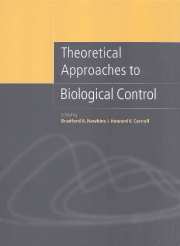Book contents
- Frontmatter
- Contents
- List of contributors
- Preface
- Part I Biological control theory: past and present
- Part II Ecological considerations
- Part III Spatial considerations
- Part IV Genetic/evolutionary considerations
- Part V Microbes and pathogens
- 17 The dynamics of insect–pathogen interactions
- 18 Host–pathogen–parasitoid systems
- 19 Persistence of natural enemies of weeds and insect pests in heterogenous environments
- 20 Application of insect–pathogen models to biological control
- 21 Dose–response relationships in biocontrol of plant disease and their use to define pathogen refuge size
- Index
19 - Persistence of natural enemies of weeds and insect pests in heterogenous environments
from Part V - Microbes and pathogens
Published online by Cambridge University Press: 13 August 2009
- Frontmatter
- Contents
- List of contributors
- Preface
- Part I Biological control theory: past and present
- Part II Ecological considerations
- Part III Spatial considerations
- Part IV Genetic/evolutionary considerations
- Part V Microbes and pathogens
- 17 The dynamics of insect–pathogen interactions
- 18 Host–pathogen–parasitoid systems
- 19 Persistence of natural enemies of weeds and insect pests in heterogenous environments
- 20 Application of insect–pathogen models to biological control
- 21 Dose–response relationships in biocontrol of plant disease and their use to define pathogen refuge size
- Index
Summary
Introduction
Classical microbial control involves the introduction of a pathogen into an ecosystem with the objective of long-term persistence of, and pest control by, the pathogen. In some cases, classical control uses several coexisting biological control agents to maintain a pest population at low levels. In managed as well as unmanaged ecosystems, populations of weeds and insects are distributed heterogeneously over space and change phenologically over time. Furthermore, the movement of pathogens and insects contributes to and is influenced by these heterogeneous environments. Mathematical models and concepts derived from model analyses should account for this variability in space and time (see Chapters 10 and 12).
Our goal in this chapter is to derive hypotheses about persistence, endemicity, and long-term coexistence of pathogens and parasitoids (Walde & Nachman (Chapter 10) emphasize the persistence of predators). After a review of weed microbial control literature, we discuss a hypothetical model of a weed species and its disease. Then we describe a case-specific model of European corn borer control by a pathogen and a parasitoid. We finish the chapter with a few remarks concerning the value of models and the need for temporal and spatial scales in hypotheses derived from models.
Microbial control of weeds
There are two dominant strategies for the utilization of pathogens to reduce weed infestations in a variety of habitats (TeBeest et al., 1992).
- Type
- Chapter
- Information
- Theoretical Approaches to Biological Control , pp. 349 - 367Publisher: Cambridge University PressPrint publication year: 1999
- 1
- Cited by



